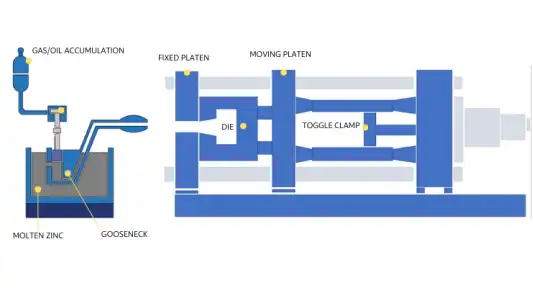
Knowledge
Advantages and Disadvantages of Hot Chamber Die Casting
Hot chamber die casting is one of the most popular and widely used manufacturing processes in the world. This process involves the injection of molten metal into a die to create complex shapes, parts, and components. It is a highly efficient and cost-effective method that produces high-quality parts with excellent surface finishes. In this blog, we will discuss the advantages and disadvantages of hot chamber die casting.
Welcome to contact Vigor for more detailed information, call us at 029 81161513 or email us at info@castings-forging.com

Advantages of Hot Chamber Die Casting
-
High-Quality Parts
Hot chamber die casting produces parts with excellent surface finishes that require little to no post-processing. This is because the molten metal is injected into the die at high pressure, which ensures that the mold is filled with molten metal evenly and uniformly. As a result, the final product has a smooth surface finish and accurate dimensions.
-
High Production Rates
Hot chamber die casting is a highly automated process that can produce high volumes of parts in a short amount of time. This is because the process is very repeatable and can produce the same part over and over again with high precision and accuracy. This makes hot chamber die casting an ideal process for mass production.
-
Cost-Effective
Hot chamber die casting is a cost-effective manufacturing process. This is because the process requires minimal tooling, which means that the initial investment is low. Additionally, hot chamber die casting produces little to no waste, which reduces material costs. This makes hot chamber die casting a great option for producing high volumes of parts at a low cost.
-
Versatile
Hot chamber die casting is a versatile process that can be used to produce a wide range of parts and components. This is because the process can handle a variety of metals and alloys, including zinc, magnesium, and aluminum. Additionally, hot chamber die casting can create complex shapes and geometries that would be difficult to produce using other manufacturing processes.
Disadvantages of Hot Chamber Die Casting
-
Limited Size and Complexity
One of the main disadvantages of hot chamber die casting is that it is limited in terms of the size and complexity of the parts that can be produced. This is because the size of the part is limited by the size of the die. Additionally, the complexity of the part is limited by the design of the die, which can be difficult and expensive to produce.
-
High Initial Investment
While hot chamber die casting is a cost-effective process in the long run, it does require a high initial investment. This is because the process requires specialized equipment, such as a hot chamber die casting machine, which can be expensive. Additionally, the cost of tooling can also be high, especially for complex parts.
-
Limited Material Options
Hot chamber die casting is limited in terms of the materials that can be used. This is because the process requires materials that can be melted at high temperatures without corroding the machinery. As a result, hot chamber die casting is typically used for metals and alloys that have a low melting point, such as zinc, magnesium, and aluminum.
Conclusion
Hot chamber die casting is a highly efficient and cost-effective manufacturing process that produces high-quality parts with excellent surface finishes. While it has some limitations, such as the limited size and complexity of the parts that can be produced, it remains a popular option for producing high volumes of parts at a low cost. If you are looking for a reliable and versatile manufacturing process for your products, hot chamber die casting may be the right choice for you.



